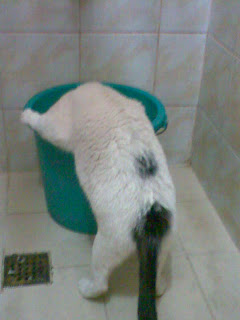This Is 15-Minutes: Russian Dreams
Some people may ask what the point is in these writing exercises I "borrowed" from gabe, the essence which is about writing non-stop for a time period (usually about 15 minutes and in my case, about a concept or a picture).
One can think the exercise akin to making paper airplanes: one uses the time and effort to craft a plane just to throw it in the air. And all for what? For the plane to crash somewhere where it can be picked up again-- or sometimes not, if it's too far to be retrieved?
Still, I figure it's worth it. After all, for one moment in time, one can experience the sheer wonder as the plane veers into the sky as if to fly forever. That's what it means to me when I do these exercises.
Sergey Korolyov heated more water again for coffee and as he waited, shivered in the early morning light.
Outside the bunker's window, he could see the slowly-rising sun light up the masive junkyard. He sighed.
At times like these, he saw how pathetically low the Russian motherland had fallen. He was a perfect example: once a brilliant scientist working for the Soviet Union, he was now nothing more than a security guard at the abandoned laboratories. How the mighty had fallen, he thought.
He lit a cigarette and exhaled a stream of smoke. Just like that, he thought, the Golden Age of Russian Scientific Dreams had blown away on the winds of history.
After the Great War, the Soviet Union had thought to come up with a more effective defense against invaders. Basing it on the ancient legend of the bronze giant Tálos, it had come up with a robot sentinel: 40-feet tall and bearing the hammer and sickle of the people it sought to protect. They called it the Iron Man.
He grinned, remembering in 1957 when their band of scientists, led by Valentin Glushko, celebrated the first activation of the robot. For almost one week, they were feted by the Soviet government.
Unfortunately, it all disappeared when the Japanese, finally done with conquering the American states in the aftermath of World War 2, started with their own version of gigantic robot warriors. First came Tetsujin-nijūhachi-gō in 1958, then Tetsuwan Atom in 1963.
But it was in 1972, when the Nippon Imperium unleashed the first human-piloted Romaji Majinga or the Demon-God against the world. Other countries, like the U.K. and the weary-beaten Germans, tried to fight back but their conventional armies were no match against the now-dubbed mecha. It was left to the Russians to stop the Japanese behemoth, as it had done before against Hitler and his Blitzkrieg.
They were so proud then, knowing that only the Soviet Union could save the world.
Sergey grimaced, his fingers dropping his now burnt-out cigarette. More fools they.
Thanks to jp for lending me the picture he found, taken from here. *winks*











